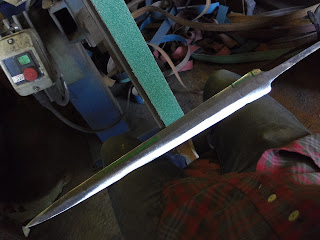This part of making a sword is transformational: it is when, both physically and metaphysically, a sword becomes. The black scale is ground away to reveal the sheen of steel, and in small but symphonic ways, weight is shaved off and a lean and slender blade emerges from the hunk of metal, like a statue being slowly rescued from its marble imprisonment by a sculptor.
The lines drawn by the hammer will cut it while you are forging, and your eyes learn to correlate highs and lows and the hammer's footprint, finding averages and drawing fat marker-lines on your piece. But that's only the beginning. Even after one pass with a course 36-grit belt, it already looks more like a sword.
 |
| My sword-forgin' flannel and my sword-grindin' pants, which still have the hole I burned in them that day with sparks. |
The beautifully bumpy lines you drew with your hammer now get leveled by a belt, becoming real lines. You begin to see what is hiding in the steel, and it's exiting and scary and a little intoxicating. It only gets more so, as the feel gets closer and closer to what's hovering above you in your artistic mind.
 |
| Smeared with anti-scale compound for the heating before the quench. Scale may form on some places of the blade, insulating it unevenly from the fast cooling of the quench. |
There is one stage that the blade undergoes during this process that happens both as soon as it can and as late as possible. The heat treatment of a blade is something I have described already but will never stop learning new things about and finding that I was doing something wrong. It's a very esoteric-seeming process of normalization/hardening/tempering/not ruining the temper. The idea is to quench it when it's thick enough that you have to worry less about warpage, but thin enough that the whole blade makes the necessary changes all the way through and so that you don't have to do a ton of grinding at high speeds, when too much friction heat can ruin the temper if you are not careful.
Owen has a classic horizontal drum-furnace outfitted with thermocouples and pyrometers to ensure the accuracy of his temperatures for the safe and consistent heating of blades to critical temperature before the quench in the heated tank of industrial quench oil nearby. The oil is in a vertical tank and is heated from below with a torch. The heating of the oil is important so as to not provide too great a shock for the dull orange blade that is quickly plunged into it vertically.
After the blade has fully cooled in the quench it is tempered in the same oven at much lower temperatures. After each tempering heat is achieved, the blade hangs vertically once again, to reduce warpage due to uneven cooling. The fragile tendency of a sword blade to submit to expansion and contraction because of thermodynamics, as well as the sometimes frustrating intrusion of gravity on hot steel, becomes a struggle, but the accuracy of using low temperatures and bending jigs means that you learn how to keep your blade straight as long as you grind evenly.
My blade slimmed down into a very serious fighting machine thereafter. Smiths often characterize the heat treat as the period when a blade becomes a blade, and after that it's all refinement. While I believe in the completion and composition of a piece from an artistic perspective, complementing a sword with all its parts and accompaniment, it's completely true that at any point after the heat treatment, the sword can fulfill its intended purpose. It's hard, flexible, and can be sharp and light and deadly. The fact that we do not stop here takes it, for me, further away from a killing object and more into the art realm, but in beautifying it we are also further perfecting it, for so much of its beauty is in its perfection of what it is.
It is truly a terrible beauty.




No comments:
Post a Comment